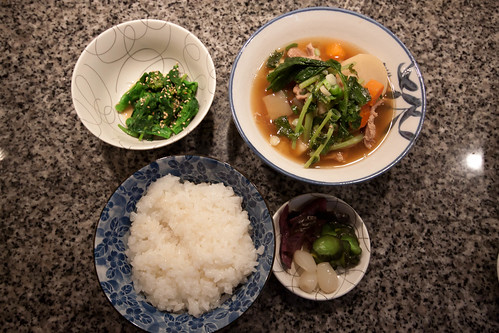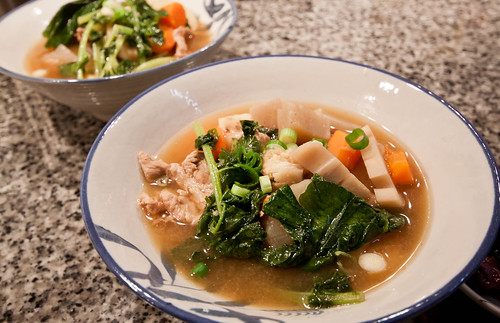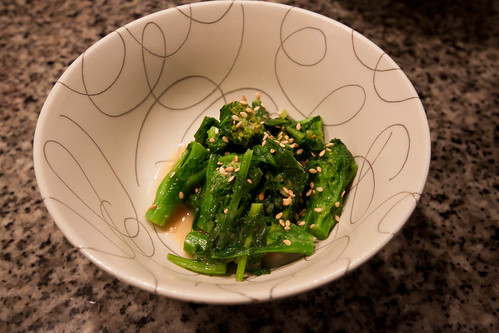The Asian recipe for this week is Tonjiru – or, Japanese pork and miso soup with root vegetables. I’ve made it a couple of times and love its ease, tastiness and generally healthy (are pork belly and “healthy” allowed in the same context?) contents. I also like this soup since it’s so flexible, and you can add or subtract ingredients to your liking and taste. For instance, the version below uses sato imo, or taro root instead of potatoes, and omits goubou (burdock root). Instead of just using Akamiso (red miso), add a little of the sweeter Shiromiso (white miso) for balance. Also, the amounts below are estimates, so please adjust as necessary. The rest of the meal included nanohana no karashi, or broccoli rabe/ rape flower with mustard dressing, rice of course, and pickles.
I usually shop at Nijiya Market for Japanese ingredients, although not everything in the photo was used in the Tonjiru. To the left is mentaiko, or spicy pollack roe – my favourite new topping for rice or mixed with soba, but that’s another post altogether. Konnyaku is in the upper left – the greyish looking block in plastic.
Tonjiru ingredients
- 6-8 cups of dashi
- 4-6 four-inch pieces of konbu
- a bag of katsuo boshi (dried bonito flakes)
- Around 4 Tbs. soy sauce
- Around 4 Tbs. Sake
- Around 2 Tbs. Mirin
- 1/2 lb. of thinly sliced pork belly (unsmoked, uncured, unseasoned bacon works fine)
- 6″ of lotus root, peeled and sliced
- 4-5 pieces of sato imo (taro root), peeled and chopped
- 2-3 carrots, cut in rounds
- 1 packet of konnyaku, first scored on the outside and then cut into pieces around the same size as the other vegetables
- 1 medium-sized daikon radish with its greens if possible, cut into rounds, greens chopped and separated.
- around 2-3 Tablespoons of Akamiso (to taste)
- 2 stem of green onion, chopped
Procedure
To make the dashi: Soak 4-6 pieces of konbu in 6-8 cups cold water, then slowly bring it to a simmer. Remove the konbu and add a generous fistful of katsuo boshi and bring to a simmer again. Remove from heat and strain the fish flakes from the broth with a fine mesh strainer or some cheesecloth.
Heat around 2 tsp. sesame oil and 2 Tbs. of regular vegetable oil into your soup pot. When the oil is hot, add the sliced pork belly and sautee until browned. Add the lotus root, sato imo, carrots, and daikon and stir to mix. Add the dashi and soy sauce, Sake and Mirin to taste. Cover and let simmer. Heat a smaller pan and dry-roast the konnyaku until the pieces are fairly dry and begin to squeak. Add the squeaky konnyaku to the soup. Continue to simmer anywhere from 20-45 minutes. When you’re ready to finish the soup, add the daikon greens. Spoon some of the hot broth into a bowl with the miso in order to dissolve the miso before adding it to the rest of the soup. Once dissolved, keep tasting until it’s to your liking. Sprinkle with green onion and serve. This makes a good 4-6 servings, depending on your portion sizes.
Nanohana Ingredients
- 1 bunch nanohana, tough stems removed for another use.
- 2 Tbs. Shiromiso
- 1/4 cup dashi
- 1/2 tsp karashi (hot mustard)
- soy sauce
- sake
Procedure
Blanch the nanohana leaves and buds in boiling water for about 2 minutes. Plunge into cold iced water to stop cooking. Once fully chilled, remove the greens from the water and squeeze out excess liquid. Make the dressing by mixing the miso and dashi and slowly adding in bits of karashi to taste. Feel free to add more if you like your dressing spicy. Add soy and sake to season to taste before mixing in the nanohana.
One Nijiya-sized bunch of nanohana makes 4 generous side servings. Your mileage may vary. 🙂



